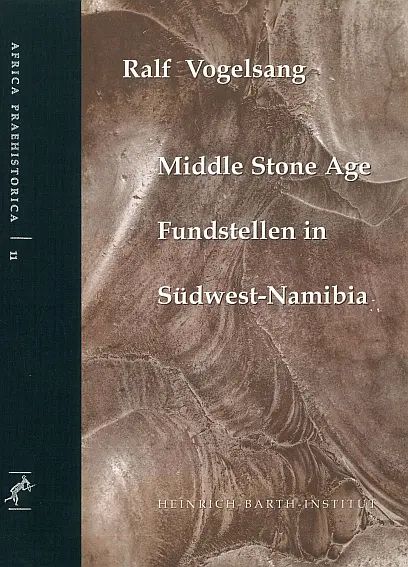- Autor/in:
- Author:
- Ralf Vogelsang
- Erscheinungsjahr:
- Publication year:
- 1998
- Reihe & Band:
- Series & Number:
- Africa Praehistorica 11
- ISBN:
- ISBN:
- 978-3-927688-17-7
- DOI:
- DOI:
- 10.18716/hbi/ap11
- Preis:
- Price:
- 69 € Aktuell: 5 €
- 69 € Discount price: 5 €
Da das früheste Auftreten des modernen Homo sapiens in der Mittelsteinzeit vermutet wird, ist dieser Zeitraum von großer Bedeutung für die prähistorische Entwicklung des gesamten südlichen Afrikas. Dies wird umso mehr durch den sensationellen Fund von bemalten Platten an der Fundstelle "Apollo 11" im südlichen Namibia untermauert. Mit einem Alter von 27.000 Jahren sind sie die ältesten Kunstwerke Afrikas und gehören zu den frühesten Kunstwerken weltweit. Die vorliegende Arbeit stellt erstmals den archäologischen Kontext dieser Funde dar und setzt sie in den kulturhistorischen Zusammenhang mit den anderen mittelsteinzeitlichen Fundstellen der Region. In den vergangenen Jahrzehnten ist die Forschung zur Mittelsteinzeit relativ vernachlässigt worden. Wolfgang E. Wendt ist der erste, der umfangreiche Ausgrabungen in Namibia durchgeführt hat. Dabei wurden an neun Fundstellen mittelsteinzeitliche Schichten gefunden, die jedoch nicht abschließend ausgewertet und publiziert wurden. Diese Fundstellen bilden die Grundlage für die vorliegende Publikation von Ralf Vogelsang. Darüber hinaus sind alle weiteren bekannten mittelsteinzeitlichen Fundstellen im Südwesten Namibias in dieser Publikation zusammengestellt. Für die wenigen multisequenzierten Fundstellen "Apollo 11", "Pockenbank" und "Bremen 1C" ist es gelungen, einen chronologischen Rahmen zu formulieren, der die kulturelle Einordnung der übrigen Grabungsbefunde ermöglicht. Die fünf ausgearbeiteten mittelsteinzeitlichen Komplexe zeigen, dass es, unabhängig von der lokalen Variabilität der Assemblagen, zu Veränderungen in der Sto
Since the earliest appearance of modern Homo sapiens is assumed in the Middle Stone Age, this particular period is of great significance in the prehistoric development of the whole of southern Africa. This is all the more endorsed by the sensational discovery of painted slabs at the site “Apollo 11” in the southern part of Namibia. At an age of 27,000 years they are the oldest works of art in Africa and are amongst the earliest art world-wide. This thesis presents, for the first time, the archaeological context of these finds, and correlates them with the historico-cultural context of the other Middle Stone Age sites of the region. In the last decades research on the Middle Stone Age has been relatively neglected. Wolfgang E. Wendt is the first to have carried out extensive excavations in Namibia. In course of his work Middle Stone Age layers were found at nine sites, although they were not finally analysed and published. These sites make up the basis of this publication by Ralf Vogelsang. In addition, all other known Middle Stone Age sites of the south-western part of Namibia are compiled in this publication. With regard to the few multi-sequenced sites “Apollo 11”, “Pockenbank” and “Bremen 1C” it has been possible to formulate a chronological framework, permitting the cultural classification of the other excavated assemblages. The five elaborated Middle Stone Age complexes point out that, irrespective of the local variability of the assemblages, there are changes of the stone artefact material reflecting superior trends. Therefore, this publication bridges and completes an incomplete stage of the Old Stone Age research in southern Africa. It also shows on the other hand the urgent need for further research in the surrounding regions, especially in the northern parts of Namibia.The present study is based upon data from all rock art within a 135 km² area of the southern Brandberg - the whole corpus of rock art from the first three volumes of H. Pager "The Rock Paintings of the Upper Brandberg". This study analyzes 17,000 figures, 2,100 scenes, 1,600 superimpositions and 327 sites, and covers the full spectrum of landscape types encountered there, from the foot of the mountain up to its peaks. This broad empirical base is the foundation of the new method of textual rock art archaeology which understands rock art as a means of human communication in which communicative utterances become comprehensible only through a matrix of rules. This study elaborates on the principles of how messages are conveyed through rock art. The method also provides insight into the meaning, the social background and the landscape setting of the rock art messages, enabling comprehensive interpretations of a life-world in terms of social and symbolic features, such as gender roles or the significance of animal motifs. However, the fundamental message of this art tradition lies in the outline of three major ideals of this prehistoric society, i.e. community, equality and mobility. In addition, rock paintings from the south side of the Brandberg, documented by E.R. Scherz from the 1960s on, are reproduced here for the first time.Since then, numerous archaeobotanical studies have been conducted to change this situation. The present volume includes 19 papers dealing with Egypt, Ethiopia, Libya, Kenya, Morocco, Namibia, the Arabian Peninsula and the Canary Islands. It contains primarily the revised and, in some instances, considerably expanded papers read during the 3rd International Workshop on African Archaeobotany which was held in Frankfurt in 2000. Presented are case studies on the plant remains from archaeological sites and museum collections, as well as ethnographic and comparative morphological and systematic investigations on living plants.

